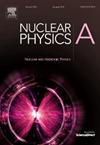The impact of deuteron breakup and neutron transfer in the d + 10B collision
IF 1.7
4区 物理与天体物理
Q2 PHYSICS, NUCLEAR
引用次数: 0
Abstract
The recently measured angular distribution data for elastic 10B(d,d)10B and inelastic 10B(d,d)10B* scattering at a deuteron energy (Ed) of 14.500 MeV—with transitions to the (1+, 0.718 MeV) and (1+, 2.154 MeV) excited states of 10B—were analyzed. Additionally, data for the 10B(d,t)9B neutron pickup reaction involving transitions to the (3/2-, 0.000 MeV), (5/2-, 2.361 MeV), and (5/2+, 2.788 MeV) states of 9B [N. Saduyev et al., Physics 6 (2024) 1098], as well as the earlier data for the 10B(d,n)11C proton stripping reaction at Ed = 11.8 MeV transitioning to the (3/2-, 0.000 MeV) ground state of 11C, were theoretically studied within the Continuum-Discretized Coupled-Channel (CDCC) and Coupled-Reaction-Channel (CRC) methods. The analysis shows that at forward scattering angles, the elastic scattering data are well reproduced by parameter-free CDCC calculations, which account for deuteron breakup effects. However, at larger backward angles, virtual effects from neutron transfer reactions become significant, while those from proton transfer are insignificant.
d + 10B碰撞中氘核破裂和中子转移的影响
分析了弹性10B(d,d)10B和非弹性10B(d,d)10B*在氘核能(Ed)为14500 MeV时的角分布数据,并跃迁到10B的(1+,0.718 MeV)和(1+,2.154 MeV)激发态。此外,10B(d,t)9B中子拾取反应的数据涉及9B跃迁到(3/2-,0.000 MeV), (5/2-, 2.361 MeV)和(5/2+,2.788 MeV)态[N]。Saduyev等人,Physics 6(2024) 1098],以及在Ed = 11.8 MeV下10B(d,n)11C质子剥离反应过渡到11C基态(3/2-,0.000 MeV)的早期数据,在连续离散耦合通道(CDCC)和耦合反应通道(CRC)方法中进行了理论研究。分析表明,在前向散射角下,考虑氘核破裂效应的无参数CDCC计算可以很好地再现弹性散射数据。然而,在较大的反向角下,中子转移反应产生的虚效应显著,而质子转移反应产生的虚效应不显著。
本文章由计算机程序翻译,如有差异,请以英文原文为准。
求助全文
约1分钟内获得全文
求助全文
来源期刊

Nuclear Physics A
物理-物理:核物理
CiteScore
3.60
自引率
7.10%
发文量
113
审稿时长
61 days
期刊介绍:
Nuclear Physics A focuses on the domain of nuclear and hadronic physics and includes the following subsections: Nuclear Structure and Dynamics; Intermediate and High Energy Heavy Ion Physics; Hadronic Physics; Electromagnetic and Weak Interactions; Nuclear Astrophysics. The emphasis is on original research papers. A number of carefully selected and reviewed conference proceedings are published as an integral part of the journal.
 求助内容:
求助内容: 应助结果提醒方式:
应助结果提醒方式:


